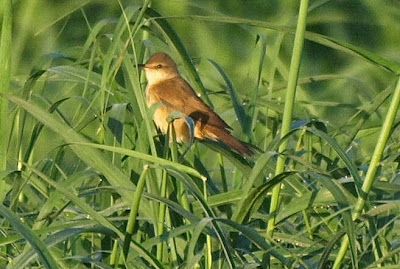blue-cheeked bee-eater
There is still significant passage for Bernard to see at Al Hayer today. Both European bee-eater and blue cheeked bee-eater were present although once again this season the latter were more numerous.
Eurasian reed warbler
Among the passage warblers the main story today was about reed warblers. Indeed we only saw one other and that was a single common whitethoart.
Almost the first bird we saw on arrival was the Eurasian reed warbler above. It took us some time to be sure of its identity particularly as in was in the very field which last week I said I doubted that a passage Eurasian reed warbler would choose over the near-by extensive reed beds. However we were able to separate it from last week's marsh warbler found near the same spot. One of characteristics was the rusty tail this bird has in contrast to the mantle but there were other reasons too.
We counted five reed warblers in the field but we pressed on in the early morning with our pre planned agenda to look for crakes and other water birds since the waters were deserted apart from us today.
Great reed warbler
Its only when we came back to them two hours later than we realised a possible tactical error. Not all the "reed warblers" at the site were the same. The second one we locked on to was a great reed warbler with its large and stout bill (apparent despite the shadow in the picture).
It proved difficult to relocate the other birds too. In retrospect we probably should have stayed with them all while we had them in our sight.
first year red-backed shrike
Near-by was a very young looking red-backed shrike and a nearly as young ortolan bunting. These were the only ones of their species we observed today.
first year ortolan bunting
Many fewer ortolan bunting have been seen this season compared with spring. This is a common story with many species. Notably exceptions have been blue-cheeked bee-eater, European roller, collared pratincole and golden oriole. At least they are colourful birds!
I am beginning to understand the different routes taken by species on passage depending on whether it is spring or autumn.
marsh harrier
No eagles have arrived yet either. We get plenty of steppe eagle, greater spotted eagle and eastern imperial eagle which stay the winter. Only a couple of marsh harrier seem to have arrived.
rows of cattle egret
A few winter birds are already here in force though. We have a few cattle egret sightings all summer though I don't know whether they breed. However today at Al Hayer there were over 60.
black winged stilt in the air
Likewise we have local black winged stilt scattered over several locations in the Riyadh area. However it would be unusual (though admittedly not impossible) to see a group of 24 in the air.
white eared bulbul
The local birds such have white eared bulbul won't have the place to themselves again until May.
Bernard and I shared camera duties today. All the photos are his except the great reed warbler, red backed shrike and blue cheeked bee-eater. I'd like to thank him for his photos and permission to crop them where necessary.
After we left Al Hayer we visited the cricket club lake. A full list of birds seen today from both places will appear in that report.










No comments:
Post a Comment